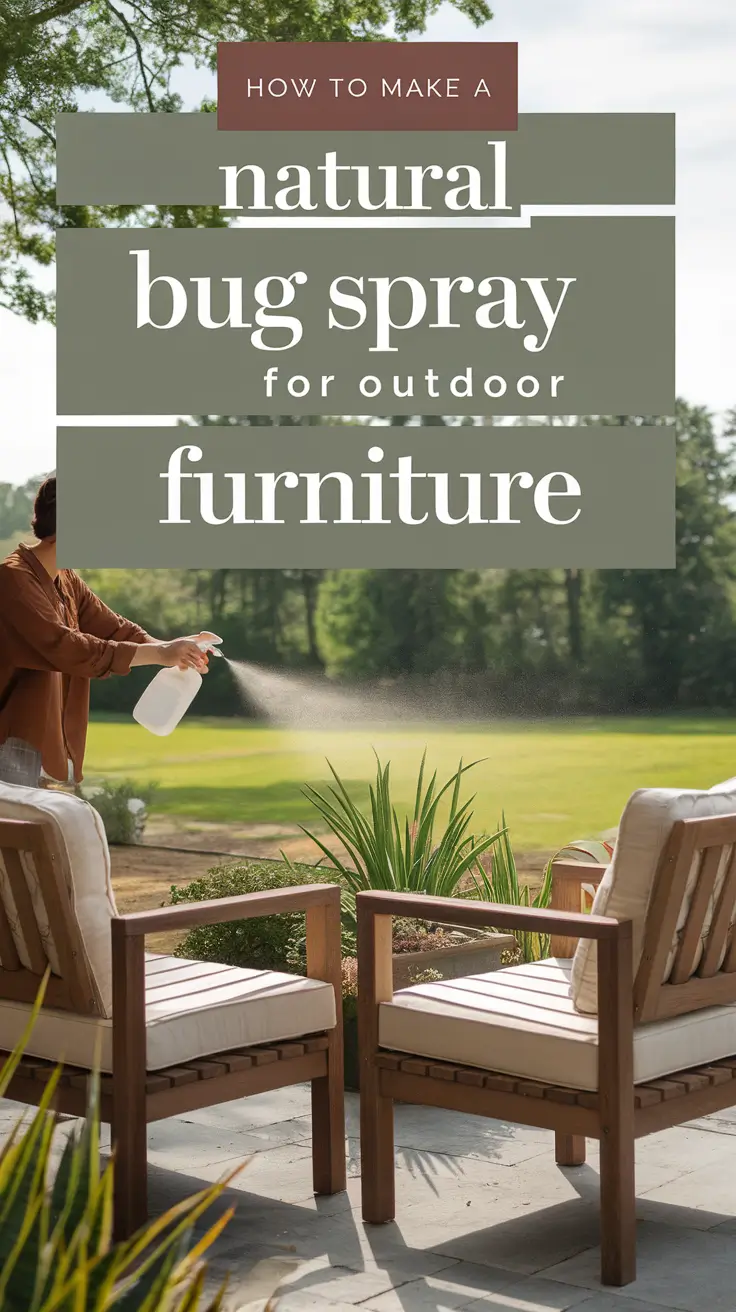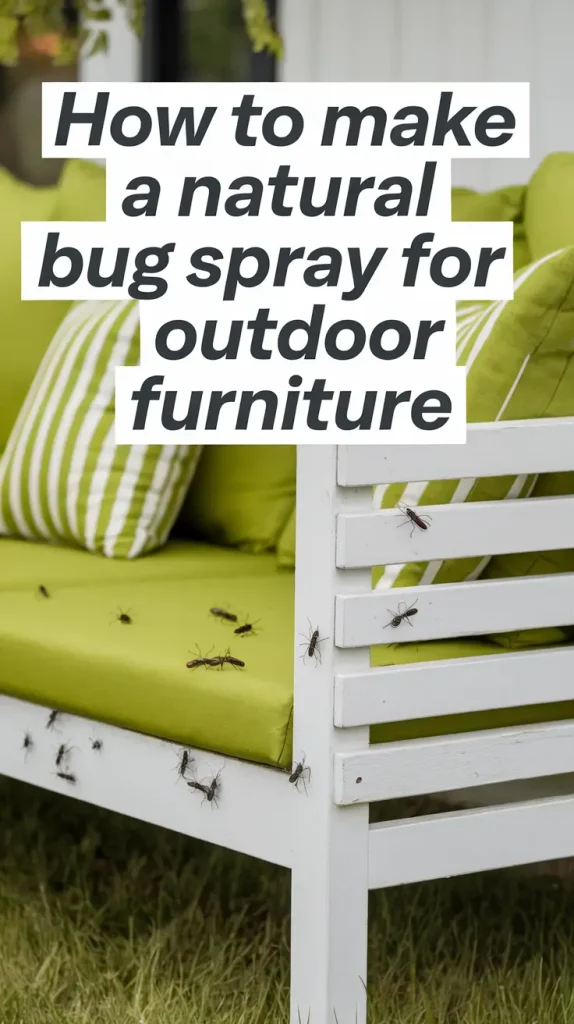Natural Bug Spray for Outdoor Furniture That Actually Works

It always starts the same way. While the sun lower, that soft, golden light shines on my garden furniture. The pitcher of lemonade is sweating on the table. A candle flickers. I sit down in my favorite spot, waiting to relax and then I hear it. That high-pitched buzz near my ear.
I used to believe that mosquitoes and gnats were inevitable during summer. I used repellents that I bought and even burned giant citronella candles. But somehow, they still found me. It was even worse because they sat on my cushions, hung around my drinks and left behind a chemical smell I wanted to avoid.
That’s when I decided to try something different. In this post, I’ll explain how I made a bug spray for outdoor furniture that is safer, smells nicer and is also effective. No harsh chemicals. No sticky residue. Only ingredients you can recognize, a recipe you know will work and a porch you’re sure to love.

Why I Stopped Using Store-Bought Bug Sprays
Here’s what I didn’t realize at first…
I thought store-bought meant safe. Many common outdoor sprays for sale have DEET, pyrethroids and artificial fragrances that are not only strong, but also stay for a long time. I would spray the chairs and cushions before guests got there, but someone would usually ask, “What’s that smell?”
Then I looked closer.
A closer look at what’s inside
- DEET is effective, but it’s also a known skin irritant—especially for sensitive individuals and pets.
- Pyrethroids, common in surface sprays, can linger on textiles for hours (sometimes days).
- Synthetic fragrances often trigger headaches and allergic reactions.
I don’t know about you, but I didn’t want to create a “clean” outdoor space that made me worry about every inhale.
The shift
Once I started reading labels and realizing how little control I had over what I was spraying on surfaces I actually touched, I made a pact with myself: try one season without the synthetic stuff. If it didn’t work—I’d go back.
Spoiler: I didn’t go back.
What Actually Works: Ingredients You Can Trust
This is where everything changed
Instead of looking at chemicals, I turned to plants—specifically, essential oils that are known to repel bugs naturally. And surprisingly? Science backs them up.
The base of a good natural bug spray
The formula I’ve found most effective is a mix of water, witch hazel (or apple cider vinegar), and essential oils with high repellent properties. Here’s what I use:
- Lemon eucalyptus oil: Clean, crisp, and backed by the CDC for its repelling power
- Lavender oil: Calming to humans, off-putting to bugs
- Peppermint oil: Invigorating, fresh, and a known deterrent for ants and mosquitoes
What to keep in mind
- Choose 100% pure essential oils (no fragrance oils or blends).
- Avoid oils you or your guests are sensitive to—especially for fabrics you’ll lean on.
- Consider mixing softer oils with stronger ones for a more pleasant scent profile.
📌 What to remember when choosing ingredients:
- Lavender is gentle and pet-friendly
- Citronella works, but can be overpowering
- Peppermint is fresh, but can irritate eyes in large doses
- Clove oil is strong against gnats but should be used sparingly
The 3 Steps That Helped Me Create My Favorite Spray
It started with a trip to the natural aisle…
I stood there staring at dozens of oils, each promising the world. But I decided to start small, with a plan to test and adjust. That made all the difference.
📌 Here’s the simple process I followed:
- Gather the essentials
I picked up:- 100ml glass spray bottle (avoid plastic—more on that later)
- Distilled water
- Witch hazel (unscented)
- Essential oils: lemon eucalyptus, lavender, and peppermint
- Blend with balance
My favorite ratio:- 100 ml distilled water
- 30 ml witch hazel
- 15 drops lemon eucalyptus
- 10 drops lavender
- 5 drops peppermint
I shake it well before each use. You’ll know you’ve nailed the blend when the smell makes you smile.
- Test and tweak
I sprayed a small patch of my cushion, waited 30 minutes, and then checked for color changes or residue. Once it passed that test, I treated the entire set.
Let me tell you—the difference was immediate.

Natural Spray Options at a Glance
This is where a chart helped me simplify everything
Once I started making variations for different spaces—like the kids’ corner or our BBQ area—I created a little cheat sheet for myself. Here it is:
| Use Case | Base Ingredients | Best For |
|---|---|---|
| General outdoor furniture | Water + witch hazel + eucalyptus + lavender | Cushions, wood, metal |
| Dining area | Water + peppermint + lavender (no clove) | Table surfaces, tablecloths |
| Kids’ space | Water + lavender + chamomile | Play mats, bean bags |
| Intense mosquito nights | Water + citronella + eucalyptus + clove | Patios, decks, planters |
Keep it simple. Swap oils to suit your setting. This table became my go-to reference when prepping different zones before gatherings.
The Most Common Mistakes I Learned to Avoid
This is the part I wish someone had told me sooner
Making your own spray sounds easy—and it is. But there are a few places where things can go wrong. I made most of these mistakes so you don’t have to.
- Using too much oil: It’s tempting to think “more = stronger,” but too many drops can irritate skin or discolor fabric.
- Using plastic bottles: Essential oils can erode plastic and leach toxins into your mix.
- Skipping the fabric test: Not all materials react well to oil blends, even diluted ones.
📌 What I do now to stay safe:
- Mix in small batches to avoid waste
- Always test on a hidden section of fabric
- Store in a cool, dark spot to preserve potency
It takes five extra minutes—but saves hours of cleanup and regrets.
How to Store and Apply the Spray Effectively
Here’s where consistency matters
If you want your spray to actually work—not just smell nice—you need to use it intentionally. It’s not a one-and-done deal.
My personal spray routine
- I mist the cushions and armrests in the morning (especially if we’re planning to sit outside in the evening).
- I reapply around sunset or before guests arrive.
- After a rain or wipe-down, I re-spray the surfaces—especially wood.
Storing your mix
- Keep it in a glass bottle (preferably amber or cobalt to block light).
- Store away from direct sunlight and heat (I keep mine in a cabinet by the back door).
- Replace the mix every 6–8 weeks, even if you haven’t used it all—essential oils can oxidize over time.
You’ll know when it’s time to refresh: the scent will fade or the spray will separate faster.
What I Gained When I Switched to a Natural Option
I find it funny that a simple DIY turned into something I now enjoy doing. Spraying the chairs now reminds me of making the space cozy, like adding fluffy pillows or turning on some candles.
In addition, I feel better knowing the ingredients in my bottle. I have observed less bug bites, a nice smell outside and my kids no longer feel guilty about sitting on the cushions.
The bonus? Some of my friends began to wonder, “What tools are you using out here? It smells so good.” That’s when I knew I was onto something.
Final Thoughts
Going natural wasn’t just about being more “green.” I wanted to make my outdoor area safer, more peaceful and personal to me. Thanks to the little spray bottle, I could enjoy my summer without the annoying buzzing and everyone could just talk and relax.
Would you try making your own version?
Pin this if you’re building your dream outdoor nook.
Of all the summer rituals which one would you never stop doing?

